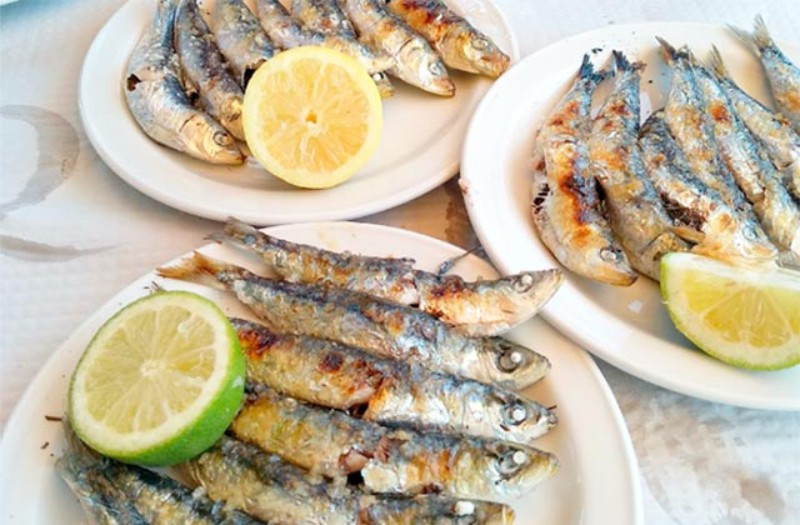Food
Amazing Facts about Espetos, a Spanish Food Dish of Skewered Sardines

Espeto, or grilling of sardines, is celebrated in Spain by the Google Doodle On June 12, 2023. Here are some interesting and amazing fun facts about Espetos. A salty, smoky aroma in southern Spain must mean a certain something: It’s espeto season. The present Google Doodle (hand-crafted with clay!) praises the flavor of the summer, a famous Spanish dish of skewered sardines that are traditionally roasted over firewood on the beach. To celebrate the traditional job, the city of Malaga unveiled a statue of the Espetero, or sardine skewers, on this day in 2006.

15 Interesting Facts about Espeto
- The Espeto is a typical dish from Málaga and the Granada Coast in Southern Spain. It is made by skewering fish, traditionally sardines, on thin and long rods and roasting them over firewood on the sand of the beach.
- Espetos is a Spanish tradition of grilling sardines. It originated in the late 19th century when fishermen used small boats on the sand to skewer and grill excess fish.
- The modern method normally includes placing 6 sardines on a skewer, seasoning them with sea salt, then, at that point, barbecuing them over the open flames of an olive wood fire.
- Olive oil and lemon juice are drizzled over the sardines after they have fully cooked and become golden on the outside. Sardines are said to be at their best from May to August when they are a little fattier and have a better flavor. In many beach bars of Malaga, espetos are matched with soda pops, lager, sangria, or Tinto de verano red wine.
- The method comprises inserting the sardines through its back and taking care that they are undeniably put similarly on the rod, above or below it. The tip is inserted into the back of the sardine at the level of the dorsal fin, skirting the spine without breaking it and exiting through the belly after the concave part of the shank is turned upward.
- The sardine row must be perpendicular to the rod. They are put next to an olive wood fire and sprinkled with salt. To keep the sardines from scorching or smoking, the wind’s direction is always checked. The wind must travel from the sardines to the flame. The ideal distance from the flame is approximately 20-30 centimeters (7.8-11.8 inches). It takes about 6 minutes to make the skewers.
- In the past, the reeds were nailed to a small sand mound, and the wood that had already been set ablaze was placed on the opposite side. At the point when it became an activity where a professional skewer cooks for a restaurant, to avoid being crouched in the sand for hours, the skewers depended on the creativity of placing sand inside a boat and raising it on trestles.
- At present, there are numerous restaurants and even town halls that place boats, in some cases made of metal, along the promenades, so they can be filled with sand and make work easier. The ease with which these modern containers can be oriented about the breeze is a benefit.
- Albeit the traditional thing is the sardine, numerous different food varieties can be spit. As a result, other fish like horse mackerel, sea bream, sea bass, and so on are frequently spit. The cane is inserted into the animal’s mouth in these cases. Seeing squid or other large mollusks is likewise normal. The embers of the skewer can be used, obviously, to roast different food sources like meat or vegetable skewers or potatoes.
- The rod on which the fish is skewered is produced using sugarcane that is cut into bits of around 50 centimeters and afterward, split in half lengthwise. The fish can be inserted into the two half rods that have been obtained by sharpening the tip. These reeds are placed on top of the coals without burning by being submerged in water in a bucket until they become moist.
- Six sardines are typically skewered on a bamboo spit to make an espeto. The best ones are medium-sized (big sardines aren’t generally seen as in the Mediterranean). Putting the sardines in an ice bucket and salting them for at least 30 minutes will also help them firm up before cooking.
- King Alfonso XII probably invented the modern espeto. According to legend, the king was first introduced to the espeto in 1884. Miguel Martinez Soler, also known as “Miguel, the Sardine Man” (Miguel, el de las Sardinas), is credited with being the chef. The king thoroughly enjoyed his dish after he insisted that he eat the sardines with his hands!
- Sardines are a great source of vitamin B and iron. They’re likewise high in Omega 3 and low in calories. One serving is around 200 calories and gives you 23 grams of protein. Likewise, because sardines are lower on the food chain, they have next to no mercury, so they’re a decent choice for kids or pregnant women.
- In Malaga, famous insight says that sardine espetos are best in the months that don’t have an “r” — in other words, May, June, July, and August. There’s one more saying that they are best from “Virgin to Virgin.” That refers to the time period between the feast of the Virgin of Victoria on September 8 and the feast of the Virgin del Carmen on July 16.
- Even though boats filled with sand and firewood are still used to prepare espeto, it is still a popular beachside snack today. Six sardines are grilled over an open wood fire and seasoned with salt by chefs. When completely cooked, the golden sardines are drizzled in lemon juice. During the summer, sardines are even more flavorful because they are more plump.
-

 Business3 weeks ago
Business3 weeks agoPrakash and Kamal Hinduja: Driving Social and Environmental Change
-
Education4 weeks ago
Fred DuVal: University Leadership as a Critical Resource for Climate Change Research and Life-Saving Solutions
-

 Cryptocurrency3 weeks ago
Cryptocurrency3 weeks agoDesigned For The Masses: How Akasha (AK1111) Is Unlocking Crypto For The Next Billion Users
-

 Health3 weeks ago
Health3 weeks agoThe Hinduja Brothers Commitment to Global Health: Empowering Communities Across Borders
-

 Cryptocurrency4 weeks ago
Cryptocurrency4 weeks agoNexaglobal & Future World Token (FWT): Could This Be the Next Big Crypto Investment of 2025?
-

 Startup2 weeks ago
Startup2 weeks agoCost-Saving Strategies Every Small Business Owner Should Know to Boost Efficiency
-

 Startup3 weeks ago
Startup3 weeks agoMatthew Denegre on the Art of Deal Sourcing: Finding the Right Investment Opportunities
-

 Health2 weeks ago
Health2 weeks agoSt. John’s Community Health Examines Innovations in Pharmacy Access













